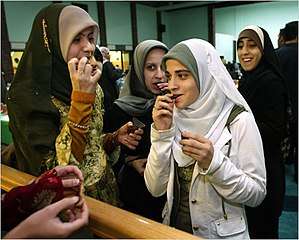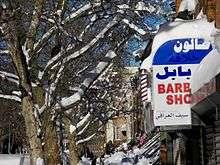Palestinian Americans
| Total population | |
|---|---|
|
85,186 | |
| Regions with significant populations | |
| North Jersey and Brooklyn; Chicago and Bridgeview, Anaheim and Los Angeles, Jacksonville; and Dearborn, Michigan and Metro Detroit. | |
| Languages | |
|
American English Palestinian Arabic | |
| Religion | |
| Minority: Christianity (Eastern Orthodoxy), (Catholicism), (Protestantism) | |
| Related ethnic groups | |
| Jordanian Americans, Syrian Americans, Lebanese Americans, Egyptian Americans and other Arab Americans |
Palestinian Americans (Arabic: فلسطينيو أمريكا), are Americans descended from the Palestinian people. It is not easy to say when the first Palestinian immigrants arrived into the United States; however, many of the first immigrants to arrive were Arab Christians escaping persecution in Ottoman Palestine in the late 19th century. Later immigrants came to the country fleeing the Arab–Israeli or Palestinian conflicts.
History

Early immigration
The first Palestinians who immigrated to the United States arrived after 1908, when the Ottoman Empire passed a new conscription law mandating Palestinians into the military[3]. Palestinian immigration began to decline after 1924, with a new law limiting the number of immigrants, as well as the Great Depression, which deeply worsened immigration.
Palestinian exodus
The population in the United States began to increase after World War II. The 1948 Arab–Israeli War, the Nakba, and the independence of the state of Israel in 1948 caused many Palestinians to immigrate, most as refugees. However, the greatest wave of Palestinian immigration began in 1967 after the Six-Day War, or as Arabs call it the June War. This wave of immigrants reached its peak in the 1980s.
Modern history
Most Palestinians that immigrated to the United States in this period were more educated than the Palestinians that arrived before 1967, thanks to the schools sponsored by the United Nations and the increasing number of universities in the Middle East.[4] Political activism by Arab Americans abruptly increased after 9/11, when Palestinian activists such as Linda Sarsour began to speak for civil rights for American Muslims[5] and human rights for Palestinians.
Demographics

U.S cities
Most Palestinians settled in the areas surrounding Paterson,[6][7] and Bay Ridge[8], which together make up the New York Metropolitan Area. Many other Palestinians settled in Chicago metropolitan area, while some others settled in the Los Angeles metro area, Metro Detroit, and Jacksonville metro; alongside other Mediterranean communities, including the Lebanese, Syrians, Greeks, Italians, Egyptians, Jordanians and Turks.
Paterson, New Jersey has its southern half of the city nicknamed Little Ramallah, with an Arab American population estimated as high as 20,000 in 2015.[9] It has the most concentrated area of Palestinian Americans in the whole United States.[10]
Bay Ridge's Arab community in Brooklyn, New York, is also a significant neighborhood home to an estimated population of 35,000[11], in which its largest Arab ethnic groups are Palestinians and Yemenis[8][12]. However, it is also home to many other Arab ethnic groups, making Bay Ridge's Arab community also a strongly diverse population.

Chicago, Illinois is also home to a significant population of Palestinians. There is an estimated population of 85,000 Palestinians in Chicago, and Palestinians form 60% of the Arab community there[13][14]. Bridgeview, Illinois, also has a significant population of Palestinians Americans.
According to the 2000 United States Census, there were 72,112 people of Palestinian ancestry living in the United States, increasing to 85,186 by the 2009-2013 American Community Survey. It is difficult to count the numbers of Palestinian Americans, since the United States does not recognize the State of Palestine, and only recognizes "Palestinian" as a nationality.
Religion
Even though many Arabs who immigrated to the United States are Christians which represent Eastern Orthodox, Catholic, Oriental Orthodox and Protestant; most Palestinian Americans practice Islam instead of Christianity.[15]
Language
Besides English, many Palestinian Americans speak Palestinian Arabic. Palestinians who once lived in Israel or the Palestinian territories may have spoken Modern Hebrew as a second language[15][16]. Many Palestinians are fluent in other languages.
Education
In the United States approximately 46% of Palestinians have obtained at least a college degree, compared to 18% of the American population.[17] The study of culture and the Arabic language is increasingly important among Palestinians, especially in college and graduate school. Thus, some Palestinian or Arab organizations are working to monitor and improve the teaching of Arab history and culture in the American schools.[4]
Socioeconomics
Among the 90 percent of Palestinian American men and 40 percent of women who are in the labor force, 40 percent and 31 percent, have either professional, technical, or managerial positions. There are also large numbers in sales: 26 percent of men, and 23 percent of women. The self-employment rate for men is a significant 36 percent (only 13 percent for women), compared to 11 percent for non-immigrant men. Of the self-employed, 64 percent are in retail trade, with half owning grocery stores. In terms of income, the mean for Palestinian families in 1979 was $25,400, with 24 percent earning over $35,000 and 20 percent earning less than $10,000[15].
Culture
Palestinian culture is a blend of Eastern Mediterranean influences. Palestinians share commonalities with nearby peoples of the Levant, including Egyptians, Lebanese, Syrians, and Jordanians.

Cuisine
Palestinians cook many foods native to Palestine, or a broader definition, the Levant. Examples are kanafeh, hummus, falafel, musakhan, waraq al-'inib, and other Palestinian dishes. These foods, such as Kanafeh, have been very popular in the United States, mostly in New York City[18].
Business
Palestinian Americans have owned Arab groceries, shops and restaurants ever since their immigration to the United States. Most of these businesses are in large cities such as New York City and Chicago[19].
Politics
While Palestinian Americans are typically not more politically active than the population at large they are very politically aware of their history and the issues facing their homeland. They are more active in social organizations, such as mosques, churches and local associations, than in political ones, though the former have strong political implications. In the absence of a Palestinian state, the unity and preservation of communities in the diaspora serve to maintain Palestinian identity.
Activism
.jpg)
After the wake of 9/11, many Palestinian Americans, such as Linda Sarsour, became activists in order to defend American Muslims, Arab and Palestinian Americans. Many of these activists support the one-state solution to the Israeli-Palestinian conflict[20]. However, they have received criticism from American conservatives for being "anti-Zionist"[21].
Government
Only several Americans of Palestinian ancestry served as congressmen. Justin Amash, is a Republican congressman of Palestinian ancestry, serving in the U.S House of Representatives representing Michigan's 3rd District.
Notable people
See also
References
- ↑ "B04001: First Ancestry Reported: 2009–2013 American Community Survey 5-Year Estimates". United States Census Bureau. Retrieved July 21, 2017.
- ↑ http://plodelegation.org/index.php/ps-us-relations/palestinian-americans
- ↑ "Palestinian Americans facts, information, pictures | Encyclopedia.com articles about Palestinian Americans". www.encyclopedia.com. Retrieved 2018-01-30.
- 1 2 Kurson, Ken. "Palestinian Americans". everyculture.com. Retrieved July 21, 2017.
- ↑ "Linda Sarsour Spoke of 'Jihad.' But She Wasn't Talking About Violence". Time. Retrieved 2018-01-17.
- 1 2 Adely, Hannan (July 19, 2014). "Hundreds of Palestinians rally in Paterson in protest of Israeli military campaign". North Jersey Media Group. Archived from the original on July 24, 2014. Retrieved July 19, 2014.
- 1 2 Cowen, Richard (May 18, 2014). "Paterson's Palestinians celebrate annual flag-raising at City Hall". North Jersey Media Group. Archived from the original on October 10, 2014. Retrieved July 19, 2014.
- 1 2 Hedges, Chris (1990-10-04). "Palestinians Struggling To Rebuild Their Lives". The New York Times. ISSN 0362-4331. Retrieved 2018-01-16.
- ↑ Yellin, Deena (May 3, 2015). "Palestinian flag-raising is highlight of heritage week in Paterson". North Jersey Media Group. Archived from the original on May 5, 2015. Retrieved May 4, 2015.
- ↑ Yoked, Tzach (2017-12-20). "New Nablus Welcome to Little Palestine, New Jersey". Haaretz. Retrieved 2018-02-10.
- ↑ "The Jew Who Helps Run an Important Arab-American Organization in Brooklyn". Tablet Magazine. Retrieved 2018-01-16.
- ↑ Robbins, Liz (2017). "Worry and Disbelief in Yemeni-American Community in Brooklyn". The New York Times. ISSN 0362-4331. Retrieved 2018-01-16.
- ↑ "Illinois Arab American Community". Arab America. Retrieved 2018-01-16.
- ↑ "Palestinians". www.encyclopedia.chicagohistory.org. Retrieved 2018-01-31.
- 1 2 3 "Palestinian Americans - History, Israel, Modern era, Significant immigration waves, Settlement patterns". www.everyculture.com. Retrieved 2018-01-26.
- ↑ "The latest hot language among Palestinians in Gaza? Hebrew". Christian Science Monitor. 2013-03-18. ISSN 0882-7729. Retrieved 2018-01-26.
- ↑ "Educational Attainment in the United States: 2012 - Detailed Tables". United State Census Bureau. Archived from the original on July 4, 2013. Retrieved June 25, 2013.
- ↑ "'Bearded Bakers' Bring Epic Dessert Party to NYC". NBC New York. Retrieved 2018-01-16.
- ↑ Sifton, Sam (2010-02-23). "Tanoreen Restaurant in Bay Ridge, Brooklyn". The New York Times. ISSN 0362-4331. Retrieved 2018-01-17.
- ↑ "Why Palestinian-American activist Linda Sarsour is controversial". Retrieved 2018-01-27.
- ↑ "Linda Sarsour: Why the Palestinian-American activist is controversial". Jewish Telegraphic Agency. Retrieved 2018-01-27.
